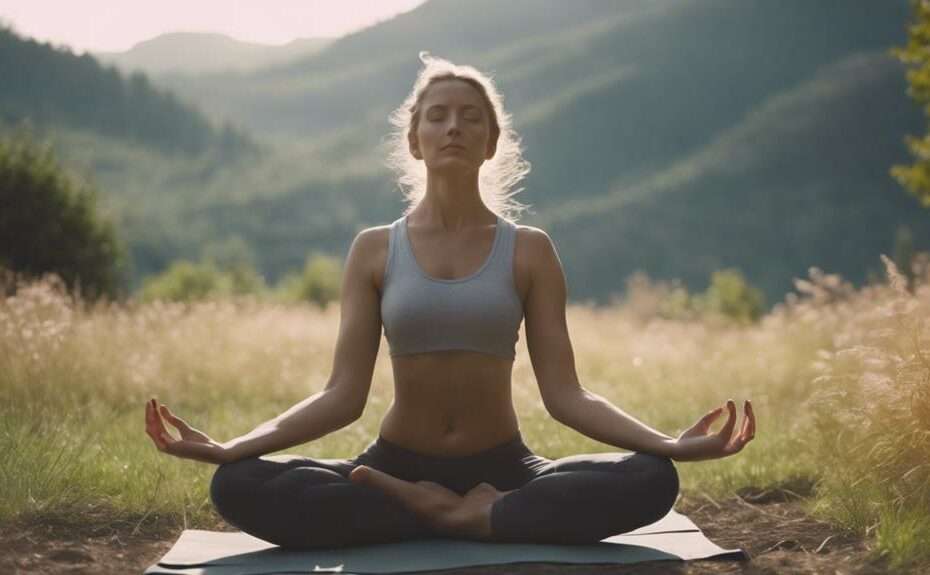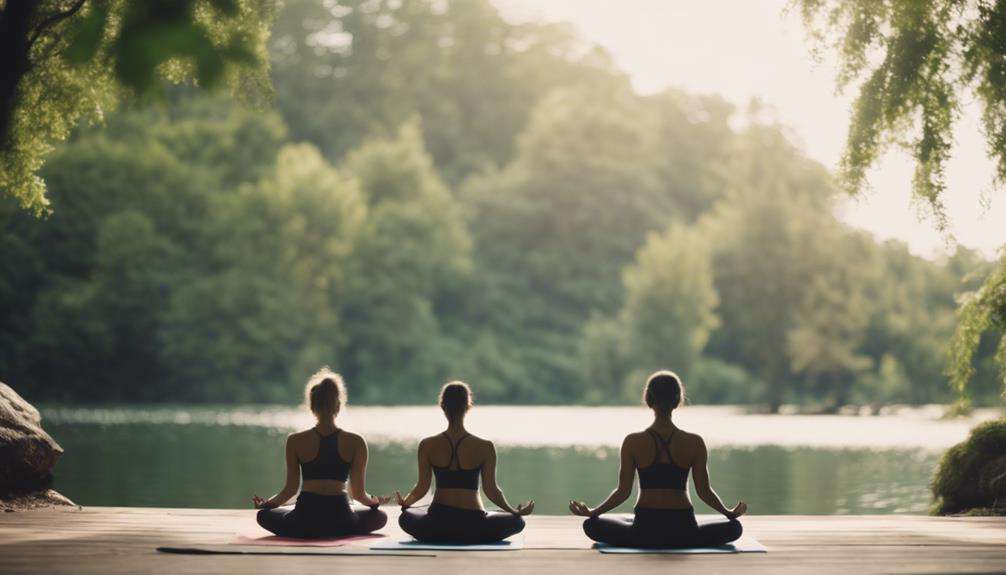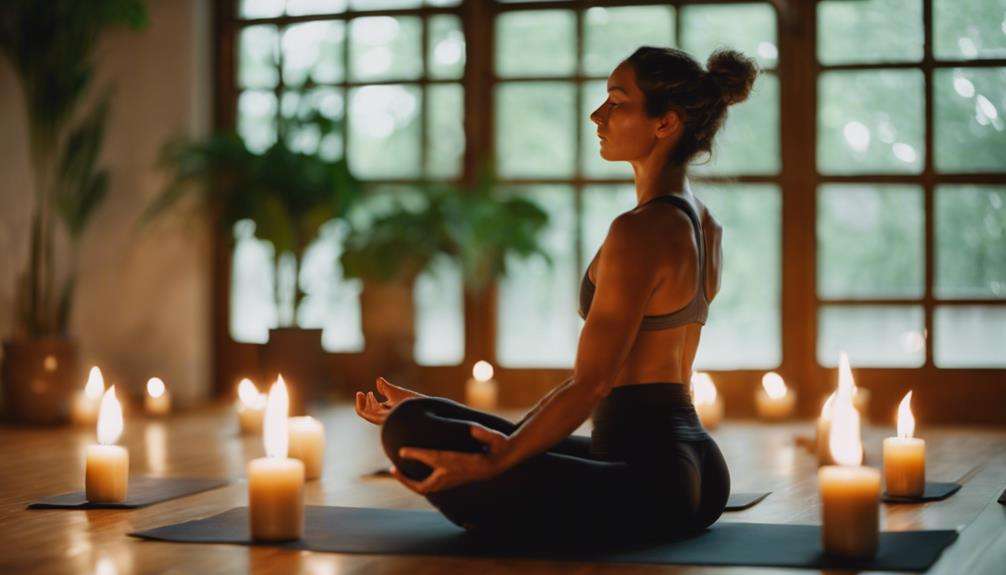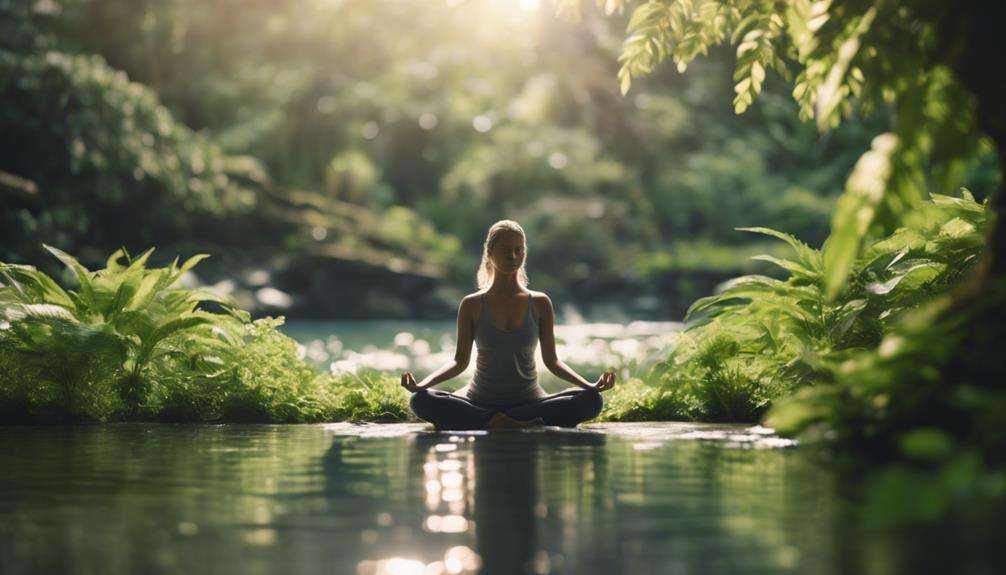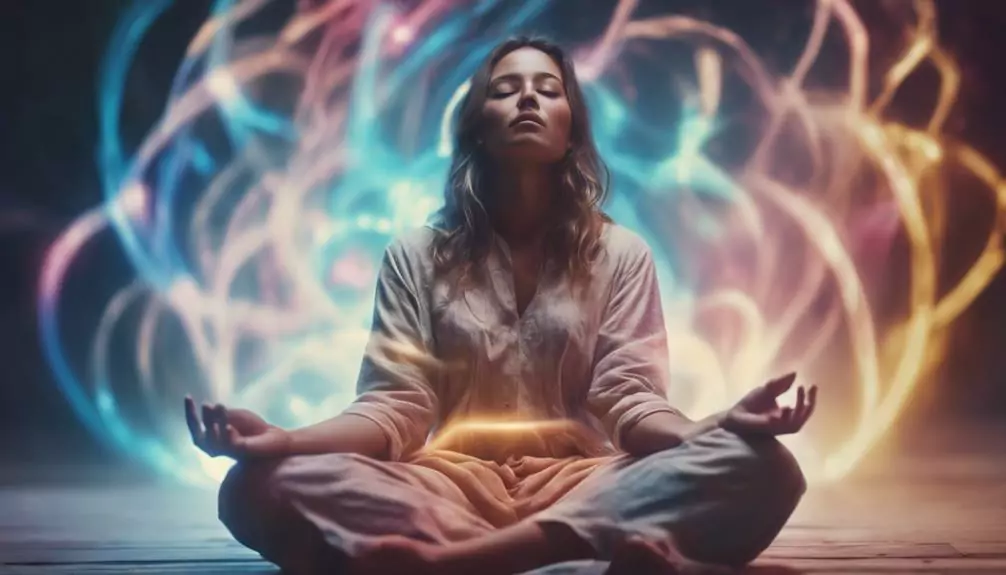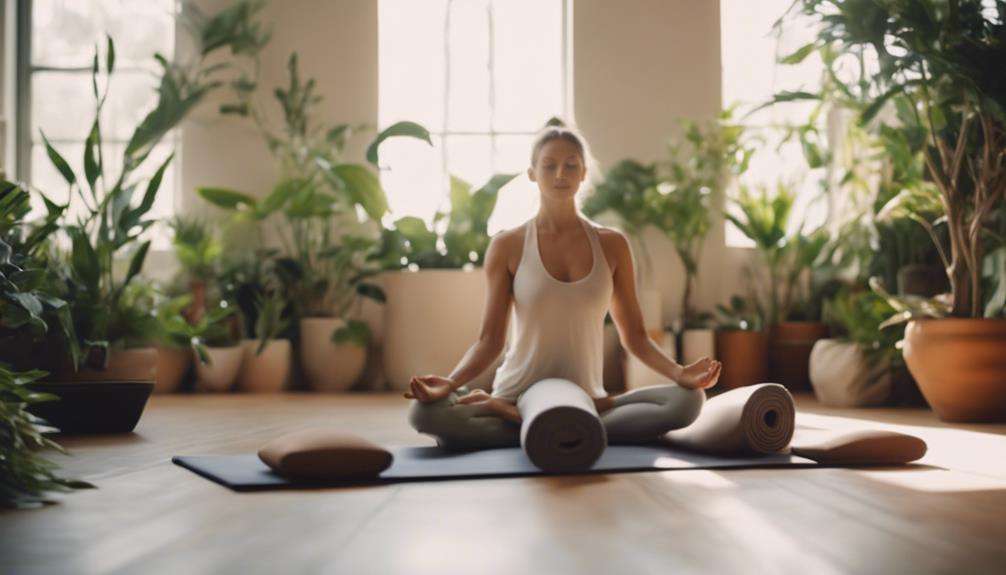You might think that advanced yoga techniques are only for the seasoned practitioner, but exploring these methods can truly elevate your mindfulness practice to new heights.
By incorporating specialized meditations like Chakra-Balancing and Tonglen, along with mastering the art of Drishti, you can deepen your awareness and connection with the world around you in ways you never imagined.
These techniques offer a gateway to an enriched mindful experience, opening up a whole new realm of possibilities for your yoga journey.
Key Takeaways
- Utilize specific mantras and colors to balance chakras effectively.
- Cultivate empathy and interconnectedness through meditation practices.
- Circulate subtle energy for vitality and stress reduction in microcosmic orbit meditation.
- Enhance focus, balance, and mindfulness with Drishti techniques in yoga practice.
Chakra-Balancing Meditation
To begin your journey into chakra-balancing meditation, focus on understanding the energy centers along your spine and how specific mantras and colors can enhance their balance and function. Each chakra corresponds to different aspects of your being, from the groundedness of the root chakra to the expansive consciousness of the crown chakra. By directing focused attention to these energy centers during meditation, you can tap into their unique qualities and promote inner peace and harmony.
As you move through this practice, you may encounter challenging poses that help activate and align the chakras. Embrace these moments as opportunities for growth and transformation. Visualizing the associated colors and chanting the specific mantras for each chakra can further amplify the effects of this meditation.
Tonglen Meditation
Embrace the transformative power of Tonglen Meditation where you give and receive compassion.
Visualize inhaling suffering and exhaling love, fostering a profound sense of connection.
Practice this breathing meditation for 5-10 minutes to cultivate purity of spirit and unleash the healing potential within you.
Compassion in Tonglen
Incorporate the essence of Tonglen meditation into your daily practice to transmute suffering into compassion and healing through visualization and intention. Practicing Tonglen allows you to delve into deep meditation while transforming negativity into empathy and compassion.
Here are some key aspects to focus on:
- Envision inhaling the pain and struggles of others.
- Imagine exhaling love, healing, and positivity.
- Cultivate a mindset of selflessness and interconnectedness.
- Embrace the practice as a powerful tool for emotional transformation.
Breathwork for Tonglen
Harness the power of your breath to engage in transformative Tonglen meditation, where negativity is transmuted into compassion through intentional breathwork.
In Tonglen, breathwork plays a crucial role in the process of visualization, where you visualize taking in the suffering and exhaling love and healing. This intentional practice of breathwork helps shift your perspective from focusing on negativity to cultivating compassion.
By incorporating breathwork into your Tonglen meditation for just 5-10 minutes daily, you can enhance your capacity for compassion and empathy towards yourself and others.
The purity of spirit that comes from transforming negativity through breathwork in Tonglen is what makes this Tibetan Buddhist practice so powerful in fostering deep compassion within oneself.
The Microcosmic Orbit
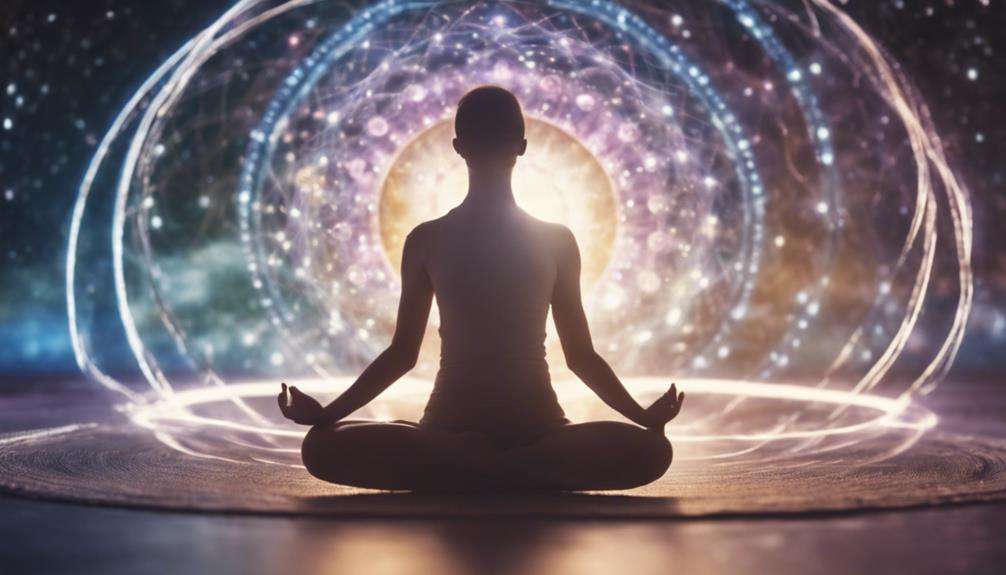
Circulating subtle energy through specific points in the mind/body system, the Microcosmic Orbit meditation is a powerful technique that energizes organs, reduces stress, and promotes overall well-being.
When practicing this ancient method, you focus your attention on guiding energy through key pathways, creating a harmonious flow within. Through visualization techniques, you envision energy moving up your spine, circulating through vital organs, and descending down the front of your body, creating a continuous loop of revitalizing energy.
The balancing effects of this practice are profound, as it helps align the body's energetic centers and enhances overall vitality. By cyclically moving energy through designated points, you unlock a sense of inner balance and tranquility.
The World Is in Me
As you embark on 'The World Is in Me' meditation practice, you invite the vastness of the universe into your awareness, fostering a sense of unity and interconnectedness.
By expanding your focus beyond the self, you begin to redefine your place in the cosmos, cultivating a deepened connection with the world around you.
This technique encourages a profound sense of unity and oneness with the universe, enhancing your mindfulness and presence in the present moment.
Self-Reflection Practice
The Self-Reflection Practice known as 'The World Is in Me' meditation technique encourages you to shift your focus from self-centered thoughts to embracing the interconnectedness of the universe. Through this yoga philosophy-inspired meditation practice, you can cultivate inner calm and a profound sense of unity with all that exists.
- Visualize your awareness expanding to encompass the world
- Feel the deep connection with your surroundings and beyond
- Embrace the oneness and unity within the cosmos
- Redefine your place in the universe, fostering a sense of interconnectedness
Inner Peace Exploration
Embark on a journey of inner peace exploration through the profound meditation technique known as 'The World Is in Me,' fostering unity and interconnectedness with the universe. By directing focused attention outward, this practice enables a shift in perspective, moving beyond self-centered awareness to encompass the vastness of the cosmos.
Through visualizing awareness expanding to include surroundings and the universe, a deepened sense of unity with the world is cultivated. This meditation redefines one's place in the grand scheme of things, emphasizing the idea of the world existing within oneself.
Embracing 'The World Is in Me' technique can lead to a profound sense of inner peace and a heightened awareness of the interconnectedness that binds us to the universe.
Drishti in Meditation
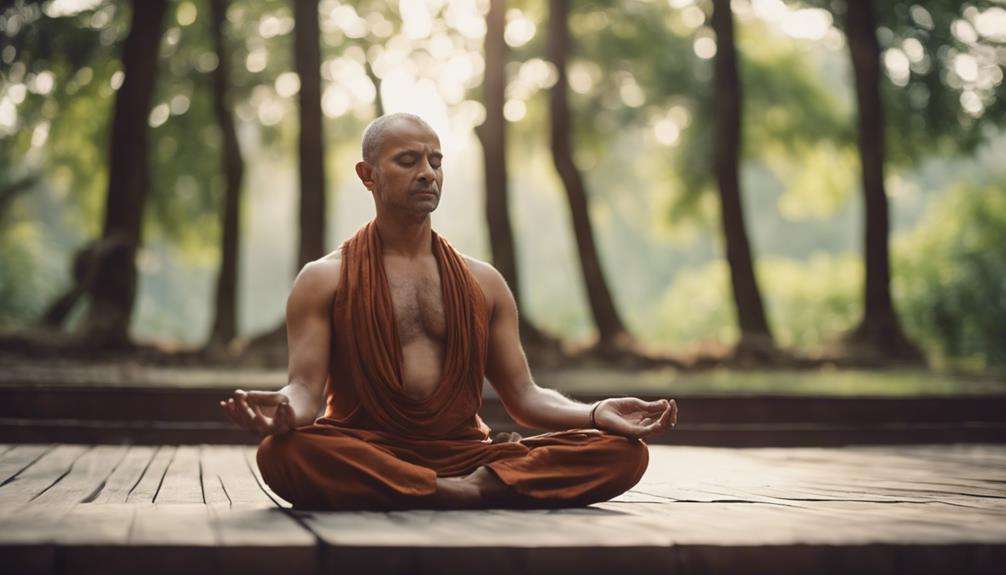
Delve into the transformative power of drishti in meditation, a practice that hones your focus and nurtures inner peace. When practicing drishti in meditation, you're encouraged to choose a specific point of focus to deepen your concentration and foster a sense of tranquility within.
- Focused Attention: Drishti encourages you to direct your attention to a single focal point, allowing distractions to fade away as you delve deeper into your meditation practice.
- Inner Stillness: By honing your focus through drishti, you can quiet the fluctuations of the mind and cultivate a profound sense of inner calm.
- Self-Reflection: The practice of drishti guides your gaze inward, prompting introspection and enhancing self-awareness during meditation.
- Enhanced Clarity: Deepening your focus with drishti can lead to heightened mental clarity, aiding in a more profound meditation experience and facilitating deeper self-discovery.
Engaging with drishti in meditation can be a powerful tool in your yoga practice, paving the way for a more focused and mindful journey within.
Drishti in Yoga
Begin your yoga practice by focusing on specific Drishti points to enhance your concentration and alignment in various poses. Drishti, or the focused gaze, is a powerful tool in yoga that helps improve your posture and deepen your mindfulness.
In standing poses, such as Tree Pose or Warrior II, maintaining a steady gaze on a fixed point can greatly enhance your balance and stability. Bahaya Drishti, the external gaze, is particularly useful for aligning your body correctly and finding balance in challenging postures. By focusing your gaze on specific points like the fingertips or a distant object, you can refine your alignment and prevent unnecessary strain on your muscles.
Incorporating Drishti into your practice not only improves your physical alignment but also cultivates a sense of inner calm and self-awareness. As you develop the skill of Drishti, you'll find that your concentration deepens, allowing you to stay present and focused throughout your practice.
Next time you step onto your mat, remember to harness the power of Drishti to elevate your yoga experience and enhance your overall well-being.
Strengthens Focus With Drishti
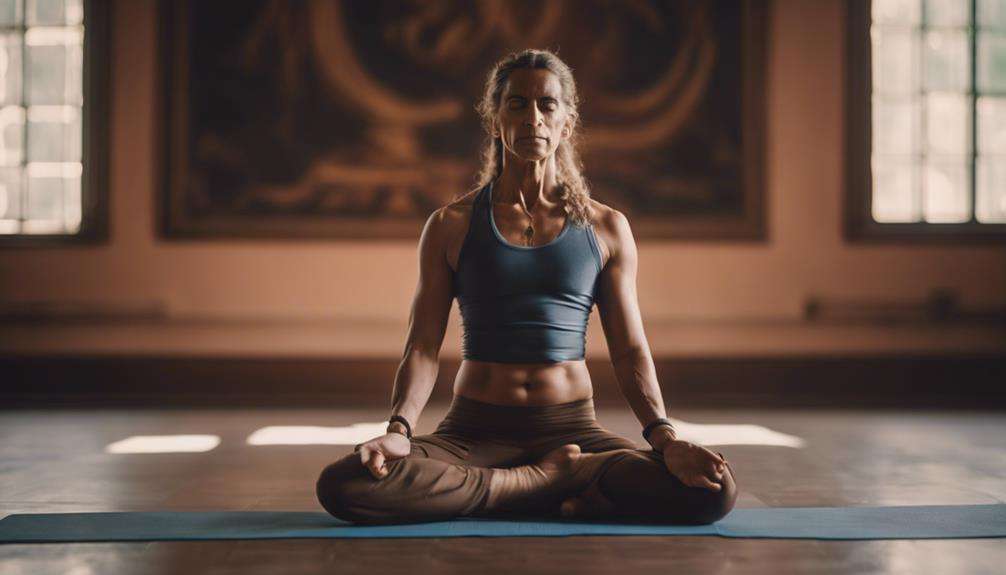
Focus is the key to unlocking deeper levels of mindfulness in your yoga practice.
Drishti, the art of focusing your gaze, can help you cultivate a strong sense of concentration and inner awareness.
Drishti for Concentration
Enhance your concentration and mindfulness in advanced yoga practice by utilizing the powerful technique of Drishti to focus your gaze on specific points. Drishti in yoga helps stabilize balancing postures, enhance alignment, and draw awareness inward.
Ashtanga Yoga specifies 9 Drishti points like Bhrumadhya and Nasagram for precise focus and alignment. Padayoragram Drishti, focusing on the toes, can enhance stability in forward bends and improve balance.
Incorporating Drishti into your practice strengthens inner calm, self-awareness, and mindfulness while engaging in advanced yoga techniques. By concentrating your gaze with purpose, you can deepen your focus, improve your balance, and cultivate a sense of centered awareness throughout your practice.
Gaze for Mindfulness
To deepen your mindfulness and strengthen your focus in advanced yoga practice, harness the power of Drishti by engaging your gaze with purpose on specific points. Drishti, a fundamental aspect of yoga, involves focusing your gaze during poses to enhance concentration, balance, and alignment.
Through Bahaya Drishti, the external gaze, you can improve stability by fixing your eyes on external objects. On the other hand, Antar Drishti, the internal gaze, enables you to direct your attention inward, fostering self-awareness and mindfulness.
Visual Focus Practice
Strengthen your concentration and alignment in advanced yoga practice by engaging in the visual focus practice of Drishti, a powerful technique that directs your gaze to specific points. When practicing Drishti, remember these key points for enhancing your mindfulness and concentration:
- Drishti involves focusing on specific points like the nose tip or thumb.
- It aids in developing mindfulness and internal awareness.
- Drishti stabilizes balancing postures and improves alignment.
- Ashtanga Yoga specifies Drishti points such as Bhrumadhya and Hastagram for refined focus.
Incorporating Drishti into your yoga routine not only deepens the mind-body connection but also fosters mental clarity, strengthens concentration, and nurtures inner calm and self-connection.
Improves Postural Alignment With Drishti
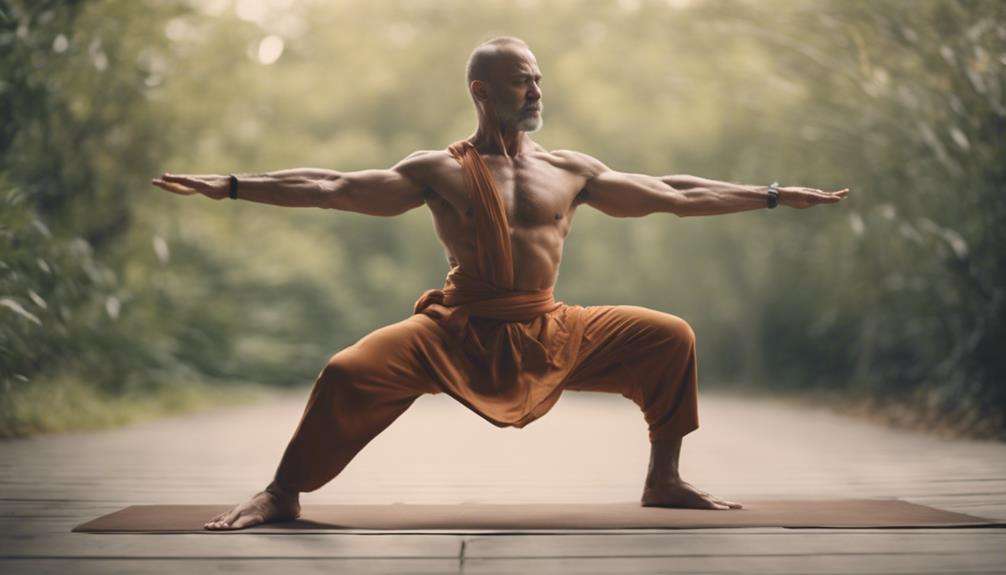
Improving postural alignment through the practice of Drishti in yoga involves focusing on specific points of gaze to enhance stability and form in various poses. By directing your gaze towards designated Drishti points, such as the tip of your nose or your fingertips, you can cultivate better alignment and concentration in yoga poses. This intentional focus not only helps stabilize balancing postures but also deepens your connection to the present moment, improving your overall mindfulness during practice.
As you incorporate Drishti into your yoga routine, remember to link your visual focus with your breath. By synchronizing your breath with your gaze, you can enhance the mind-body connection and elevate your practice to a more meditative state. Furthermore, following the Drishti guidelines outlined in Ashtanga Yoga can aid in refining your alignment and fostering a sense of inner awareness as you move through different poses.
Through consistent practice of Drishti, you can experience increased balance, stability, and mindfulness in your yoga practice, ultimately leading to a more profound mind-body connection and enhanced overall well-being.
Mindfulness Development Through Drishti
Enhance your mindfulness practice through the transformative technique of Drishti in yoga, fostering deep concentration, balance, and alignment. Drishti, a powerful tool in yoga, can significantly enhance your mindfulness journey. By incorporating Drishti into your practice, you can experience a profound connection between your mind and body, allowing for a more profound sense of awareness and presence.
Here are some essential aspects of Drishti to consider:
- Bahaya Drishti: Utilize external gazing to improve posture and stability in yoga postures.
- Antar Drishti: Engage in internal gazing to deepen self-awareness and introspection during your practice.
- Concentration Transition: Drishti aids in transitioning from focused concentration to a meditative state, nurturing inner calm.
- Mindfulness Development: Through Drishti, you can enhance your ability to maintain balance, alignment, and focus in challenging yoga poses, ultimately fostering mindfulness in every aspect of your practice.
Deepening Mindfulness: Drishti Benefits
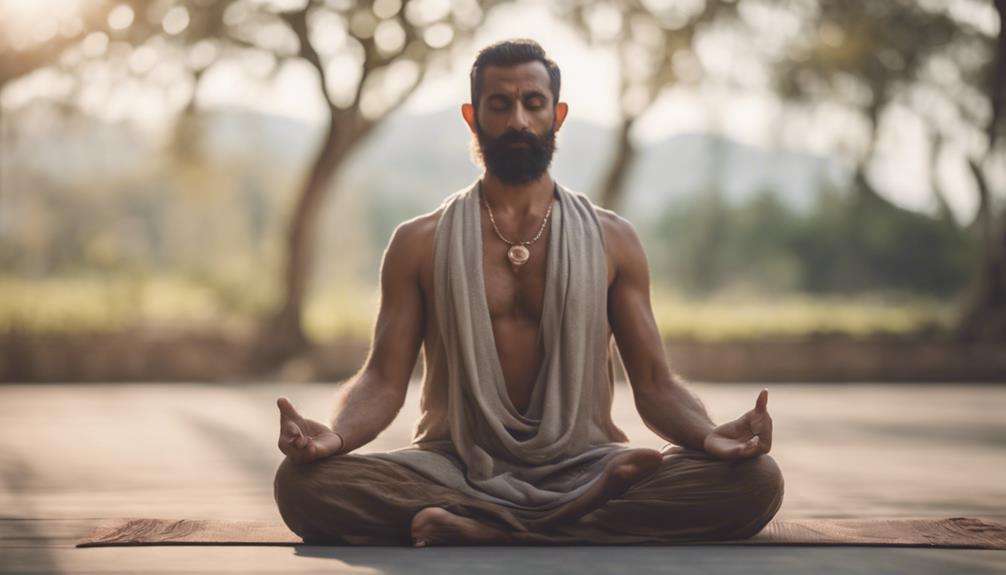
Deepen your mindfulness practice and unlock the transformative benefits of Drishti through focused attention on specific points in yoga postures. Drishti, a technique in yoga, involves concentrating on particular focal points such as the floor, nose tip, or third eye. By honing your Drishti skills, you enhance your concentration, physical balance, and alignment within yoga postures, elevating your practice to new heights.
There are two main types of Drishti: Bahaya Drishti, where you gaze at external objects to maintain balance and alignment, and Antar Drishti, which involves internal focus, aiding in transitioning to a meditative state. Regular practice of Drishti not only improves your mindfulness but also enhances self-awareness and inner calm. By incorporating Drishti into your yoga routine, you can deepen your connection between mind and body, fostering a sense of presence and awareness that carries beyond the mat.
Embrace the power of Drishti to enrich your yoga practice and cultivate a deeper sense of mindfulness.
Frequently Asked Questions
What Is the Best Yoga Style for Mindfulness?
For mindfulness, Vinyasa Flow and Kundalini Meditation offer a moving meditation experience. Restorative Yoga and Walking Meditation aid introspection. Ashtanga Practice and Breathing Techniques promote discipline. Yin Yoga enhances body awareness. Choose a style that resonates with your journey.
What Is the Most Advanced Yoga Pose?
Mastering the most advanced yoga pose involves challenging arm balances, inversions, backbends, and hip openers. Scorpion Pose demands exceptional flexibility, strength, and mental focus, pushing boundaries to deepen your practice and enhance mindfulness effectively.
How Does Yoga Increase Mindfulness?
Yoga deepens mindfulness through breath awareness, body sensations, meditation integration, and mind-body connection. Focusing on the present moment, aligning movements with awareness, and calming the mind through practices like pranayama fosters self-awareness and mental clarity.
How Can I Deepen My Practice in Yoga?
To deepen your practice in yoga, focus on breath control like a gentle breeze guiding you. Embrace meditation techniques for stillness, body awareness for alignment, and mind-body connection for unity. Trust the process, and enjoy the journey within.
Conclusion
You've learned about advanced yoga techniques that deepen mindfulness effectively. Did you know that practicing these techniques can improve concentration by up to 50%?
By incorporating Chakra-Balancing Meditation, Tonglen Meditation, The Microcosmic Orbit, The World Is in Me, and mastering Drishti, you can enhance your mind-body connection and expand your awareness.
Keep exploring these practices to deepen your mindfulness and spiritual insight, leading to a more profound sense of unity with the universe.
